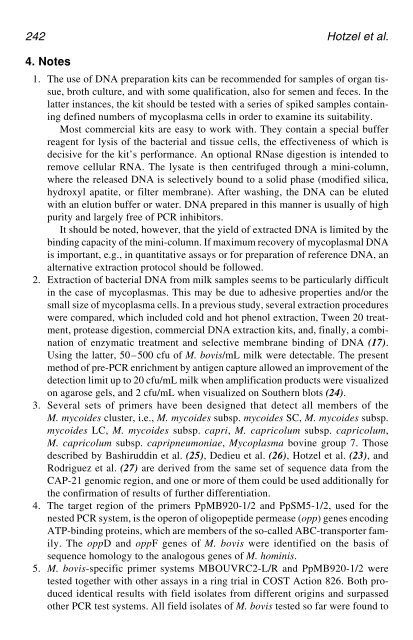PCR Detection of Microbial Pathogens PCR Detection of Microbial ...
PCR Detection of Microbial Pathogens PCR Detection of Microbial ...
PCR Detection of Microbial Pathogens PCR Detection of Microbial ...
You also want an ePaper? Increase the reach of your titles
YUMPU automatically turns print PDFs into web optimized ePapers that Google loves.
242 Hotzel et al.<br />
4. Notes<br />
1. The use <strong>of</strong> DNA preparation kits can be recommended for samples <strong>of</strong> organ tissue,<br />
broth culture, and with some qualification, also for semen and feces. In the<br />
latter instances, the kit should be tested with a series <strong>of</strong> spiked samples containing<br />
defined numbers <strong>of</strong> mycoplasma cells in order to examine its suitability.<br />
Most commercial kits are easy to work with. They contain a special buffer<br />
reagent for lysis <strong>of</strong> the bacterial and tissue cells, the effectiveness <strong>of</strong> which is<br />
decisive for the kit’s performance. An optional RNase digestion is intended to<br />
remove cellular RNA. The lysate is then centrifuged through a mini-column,<br />
where the released DNA is selectively bound to a solid phase (modified silica,<br />
hydroxyl apatite, or filter membrane). After washing, the DNA can be eluted<br />
with an elution buffer or water. DNA prepared in this manner is usually <strong>of</strong> high<br />
purity and largely free <strong>of</strong> <strong>PCR</strong> inhibitors.<br />
It should be noted, however, that the yield <strong>of</strong> extracted DNA is limited by the<br />
binding capacity <strong>of</strong> the mini-column. If maximum recovery <strong>of</strong> mycoplasmal DNA<br />
is important, e.g., in quantitative assays or for preparation <strong>of</strong> reference DNA, an<br />
alternative extraction protocol should be followed.<br />
2. Extraction <strong>of</strong> bacterial DNA from milk samples seems to be particularly difficult<br />
in the case <strong>of</strong> mycoplasmas. This may be due to adhesive properties and/or the<br />
small size <strong>of</strong> mycoplasma cells. In a previous study, several extraction procedures<br />
were compared, which included cold and hot phenol extraction, Tween 20 treatment,<br />
protease digestion, commercial DNA extraction kits, and, finally, a combination<br />
<strong>of</strong> enzymatic treatment and selective membrane binding <strong>of</strong> DNA (17).<br />
Using the latter, 50–500 cfu <strong>of</strong> M. bovis/mL milk were detectable. The present<br />
method <strong>of</strong> pre-<strong>PCR</strong> enrichment by antigen capture allowed an improvement <strong>of</strong> the<br />
detection limit up to 20 cfu/mL milk when amplification products were visualized<br />
on agarose gels, and 2 cfu/mL when visualized on Southern blots (24).<br />
3. Several sets <strong>of</strong> primers have been designed that detect all members <strong>of</strong> the<br />
M. mycoides cluster, i.e., M. mycoides subsp. mycoides SC, M. mycoides subsp.<br />
mycoides LC, M. mycoides subsp. capri, M. capricolum subsp. capricolum,<br />
M. capricolum subsp. capripneumoniae, Mycoplasma bovine group 7. Those<br />
described by Bashiruddin et al. (25), Dedieu et al. (26), Hotzel et al. (23), and<br />
Rodriguez et al. (27) are derived from the same set <strong>of</strong> sequence data from the<br />
CAP-21 genomic region, and one or more <strong>of</strong> them could be used additionally for<br />
the confirmation <strong>of</strong> results <strong>of</strong> further differentiation.<br />
4. The target region <strong>of</strong> the primers PpMB920-1/2 and PpSM5-1/2, used for the<br />
nested <strong>PCR</strong> system, is the operon <strong>of</strong> oligopeptide permease (opp) genes encoding<br />
ATP-binding proteins, which are members <strong>of</strong> the so-called ABC-transporter family.<br />
The oppD and oppF genes <strong>of</strong> M. bovis were identified on the basis <strong>of</strong><br />
sequence homology to the analogous genes <strong>of</strong> M. hominis.<br />
5. M. bovis-specific primer systems MBOUVRC2-L/R and PpMB920-1/2 were<br />
tested together with other assays in a ring trial in COST Action 826. Both produced<br />
identical results with field isolates from different origins and surpassed<br />
other <strong>PCR</strong> test systems. All field isolates <strong>of</strong> M. bovis tested so far were found to






